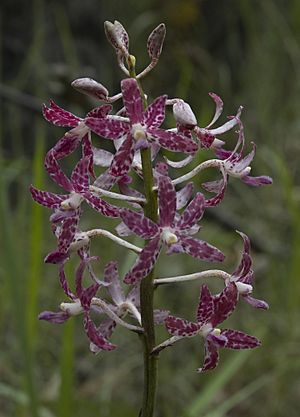Slender hyacinth orchid facts for kids
Quick facts for kids Slender hyacinth orchid |
|
|---|---|
 |
|
| Dipodium variegatum in Meroo National Park | |
| Scientific classification | |
| Genus: |
Dipodium
|
| Species: |
variegatum
|
The Slender hyacinth-orchid (Dipodium variegatum) is a special type of orchid that grows in south-eastern Australia. Unlike most plants, it doesn't have leaves! Instead, it gets its food by teaming up with tiny underground fungi. This orchid is also known as the blotched hyacinth-orchid because of its spotted flowers. It forms a close relationship with fungi from the Russula group.
Contents
What the Slender Hyacinth-Orchid Looks Like
The Slender hyacinth-orchid is a unique plant because it has no leaves. For most of the year, it stays hidden underground. It has thick roots and shoots that look like leaves, but they are actually special coverings called bracts. These shoots sometimes poke out of the ground.
The orchid blooms in the summer, usually from December to February. Its flowering stem can grow from 15 to 60 centimeters (about 6 to 24 inches) tall. Each stem can have anywhere from 2 to 50 flowers.
The flowers are thick and feel a bit fleshy. They are usually cream-colored or light pink with dark red (maroon) spots. The outer parts of the flower, called sepals and petals, are about 11 to 15 millimeters (0.4 to 0.6 inches) long and 3 to 5 millimeters (0.1 to 0.2 inches) wide. They often bend back slightly.
The special lip-like petal, called the labellum, is about 6 to 15 millimeters (0.2 to 0.6 inches) long and can be purple or dark red. It has two fuzzy ridges near its base and a line of purple hairs about 1 millimeter (0.04 inches) long down the middle. The seed pods (ovaries) are curved and bumpy. They, along with their stalks, have clear dark red spots and are about 10 to 17 millimeters (0.4 to 0.7 inches) long.
Sometimes, you can find a version of this orchid where the sepals and petals are completely dark red.
This orchid looks a bit like another species called D. roseum. However, the Slender hyacinth-orchid has spotted seed pods, which helps tell it apart from other Dipodium species in Australia.
How It Got Its Name
The Slender hyacinth-orchid, Dipodium variegatum, was officially described in 1987. Two Australian plant experts, Mark Clements and David Jones, gave it its scientific name. They published their description in a scientific paper.
The first plant used to describe the species (called the type specimen) was found next to the Pacific Highway in Beenleigh, Queensland. The second part of its name, variegatum, is a Latin word. It means "of different sorts" or "having different colors," which fits well with its spotted flowers.
Where It Lives
The Slender hyacinth-orchid can be found in the eastern parts of Queensland, stretching north to the Mount Windsor Tableland near Daintree National Park. It also grows in New South Wales, as far west as Temora. In Victoria, it is only found in the far eastern areas.
This orchid is quite adaptable and can grow in many different places. You might find it in open, shrubby areas (called heath) or in wet forests.
How It Lives and Grows
This orchid has a special way of getting its food. It forms a close partnership with certain types of fungi, especially Russula solaris and R. occidentalis. This partnership is called a mycorrhizal association. Many orchids in the Dipodium group rely on fungi from the Russulaceae family.
Scientists think that the orchid might also have a connection with Eucalyptus trees through these fungi. The fungi can link the orchid to the trees, helping them share nutrients.
Like all orchids in its group, the Slender hyacinth-orchid is pollinated by native bees and wasps. These insects help the orchid make seeds so new plants can grow.
Protecting the Slender Hyacinth-Orchid
The Slender hyacinth-orchid is considered "rare" in Victoria. This means there aren't many of them left in that state. The Victorian Department of Environment and Primary Industries keeps a list of rare or threatened plants to help protect them.
Why It's Hard to Grow
It's very difficult to grow leafless Dipodium orchids, like the Slender hyacinth-orchid, in gardens or nurseries. This is because we can't easily recreate the special partnership they have with their underground fungi. Without the fungi, these orchids can't get the food they need to survive outside their natural home.

